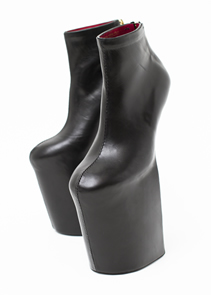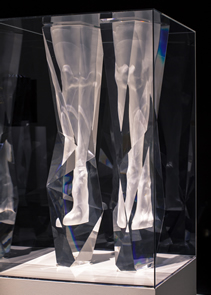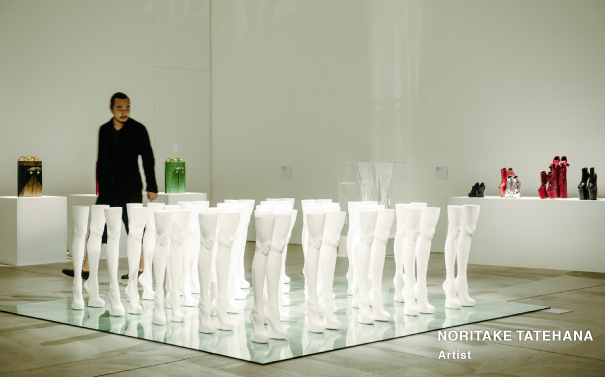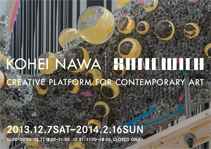
46 Noritake Tatehana (Artist)

The works of artist Noritake Tatehana - also known as the designer of Lady Gaga's iconic heelless shoes - are currently being shown at the 21_21 DESIGN SIGHT's "Image-Makers" exhibition. For the main photos of this interview, Tatehana posed in front of his works being displayed. We asked him questions such as how he got starting in making things, why he became an artist, and what he dreams of doing in the future. We got some unexpected replies.
The lack of communication skills led me to make things
I became an artist because, to put it very simply, I am searching for myself. Self-expression allows one to look at oneself objectively. The biggest theme for me is the question of who I am. I'm constantly trying to find an answer to that. And the reason I keep exploring is because I don't have confidence in myself. I started making things because I'm not good at communicating with people.
Of course, since I now work like this, I've become better at talking, but that's only because I practiced. Since I was a child, I haven't been good at conversation. So instead of talking, I made things. For example, I would give a cute girl a handmade bracelet as a present. Or when I wanted my mother to play with me but didn't have the nerve to ask, I would make origami to get her attention. (laughs)
I may not have talked to the girl or to my mother, but there was still communication between us. If I hadn't started making shoes, I probably wouldn't have become an artist, and I wouldn't be here talking today in front of an audience. So I suppose the things I made served as communication tools.

"Image-Makers" exhibition
An exhibition of works by artists with a prominent "image-maker" spirit. Creations by Jean-Paul Goudeas which have influenced creators worldwide are on display, as well as those by Jun Miyake, Robert Wilson, David Lynch, Noritaka Tatehana and the photographer Hal. Held at 21_21 DESIGN SIGHT until Oct. 5 (Sun), 2014.
Studying Japanese fashion to gain recognition
Recently I've started making sculptures and other things, but I started out as a fashion designer. I thought the job would let me be involved with people. After all, clothes and shoes have to be worn by someone. Of course, paintings and sculptures can belong to people too, but clothes are more personal and they are the means for adornment. I wanted to make things that people would find useful and pleasing, and fashion was what I felt most familiar with.
At university, I studied dyeing and weaving, and I practiced dyeing kimono and making geta (Japanese clogs). When I made the decision to become a fashion designer, I thought I should aim to be recognized overseas. The reason was simple: the Western clothes we are wearing now did not originate in Japan. People aiming to become chefs of French cuisine go to Paris, and like them, I wanted to play the game in the place where it all started.
And I wondered what my strong point would be if I went overseas. I thought hard about what I could do that others couldn't, and I saw that it would be creating things with Japaneseness. I'm Japanese and can't become French, so I wouldn't be able to win if I went abroad and studied foreign fashion. It occurred to me that the fastest way to being recognized in the world was to study Japanese fashion. I have more opportunities to work abroad now, but I always try to be as Japanese as possible. I even pay attention to the Japaneseness of my appearance - I used to dye my hair, but I've stopped doing that.
Lady Gaga's request for the heel-less shoes
When I graduated from college in March 2010, the first thing I did was try to approach people abroad. I took photos of the dresses and shoes I'd made for my graduation project at Tokyo University of the Arts, and I sent them with an email to addresses worldwide. Of course, I didn't have any contacts, so I netsurfed and found the email addresses from the websites of stylists and publishers and so on.
I think I sent about a hundred emails, and got replies from only three people. It was inevitable though, since I wasn't well-known or anything. One of the three people was Suzie Lau, the famous fashion blogger who lives in London. Another was an American journalist residing in Japan. And the third was Nicola Formichetti, the personal stylist for Lady Gaga.
I was told that in a week, Lady Gaga would be coming to Japan and appearing on the "Music Station" program. I was asked to make a pair of shoes as quickly as possible, and so I made the heelless shoes. What was good about my shoes? Well, I always make things on the theme of "tradition and contemporariness: by blending the Japanese identity or the important elements of Japanese culture with contemporary elements, I try to make things that point to the future. Perhaps that resonated with Lady Gaga since she is a person who creates the future.

Heelless shoes
Made in materials such as leather, and adorned in a variety of ways such as with crystals and gold studs, the heelless shoes have become iconic items of Lady Gaga. A pair is owned by the Metropolitan Museum of Art in New York. At the "Image-Makers" exhibition, there is an area where visitors can try on a pair of heelless shoes.

Showing Japanese culture and craftsmanship
For the "Image-Makers" exhibition, I was naturally conscious of making things reflecting tradition and contemporariness. "Frozen Boots" has a modern look and was made using modern technology. In contrast, the box for the "takageta" (tall clogs) was made in the traditional way: the "raden" technique of decorating wood and lacquer with shiny seashells was employed, and everything was handcrafted by the artisans.

Frozen Boots
Acrylic sculpture of legs wearing boots. The latest technology was employed, with 3D scanning made of long leather boots, and 3D modeling made of crystal. The work is seamless.

Floating World
Footwear which are about 40 cm high inspired by the "takegeta" (tall clogs) worn by the "oiran". Traditional Japanese crafting techniques have been used in the dyeing of the leather, and in the making of the gold "suzu" bells. At the "Image-Makers" exhibition, a silver pair of the "takageta" is exhibited in a "raden" decorated box.
With the "takageta", I tried to express in an easy-to-understand way the two-dimensional, flat aspects and stylized forms of Oriental art. Meanwhile, the heelless shoes are three-dimensional and sculptural, and representative of Western art. I wanted to show how Japan has absorbed all kinds of cultures since the Edo period, and what it is like today. I wanted visitors to see how the history of art is all linked. The tools might change - you might use your own hands or computers or machines - but the fundamentals remain the same. All my works have been made with the desire to show people the wonderful Japanese culture and craftsmanship that have been handed down through the ages.
When I was a student, I felt that things I hadn't made with my own hands couldn't be called my own works. But I realize now that this isn't so. Another thing I've come to realize is that an artist is someone who sends out information, and it's important to try to keep people informed. For example, we need to tell people about things like the current condition of artisans in the traditional crafts industry and the steps that should be taken for the future. So these days, I try to visit the provinces as much as I can to work together with the artisans. We're only halfway there, but I'm hoping to set up some sort of system that will help vitalize the provinces.
Making things is energy-consuming
It's not easy being an artist. I think it's a tough job. I dreamt of becoming an artist, and now that I really am one, I'm a bit overwhelmed by the path I've chosen... When I was a student, I did only what I wanted to do, but now I can't turn away from the things that must be done. Instead of desire, I now feel an obligation - a sense of responsibility. It's like a mission; I feel there are certain steps that need to be taken.
I find that making something with my own hands is very taxing and energy-consuming; there's real pain in giving birth. I try to stay away from it as much as I can; these days I make things about once a week if at all. (laughs) Actually, I'm joking but it's true that I'm quite busy with matters like meetings for projects and compiling data..I don't mean to sound negative when I say I don't want to make things; I actually feel joy in being able to work as a team with everyone.
There is no such thing as artistic sense or talent
I'm often asked how I get my inspiration. But there is no such thing as artistic sense or talent. When I went to preparatory school, I was the worst student at drawing, and I failed the entrance exams of all the universities except Tokyo University of the Arts. People born with good artistic sense and drawing skills are special people like Leonardo da Vinci and Picasso. Such people are born about once in 200 years. (laughs)
The important thing is to observe and appreciate a lot of different things. The more things you see, the more drawers in your closet you have. In order to have many drawers, you need to be attentive in your everyday life to all kinds of phenomena. This is something that anyone can do - you just need to do it.
I often hear people talk about ideas coming to them when they are in the bath, but that kind of convenient thing doesn't happen to me. When I need an idea, I just open the drawers in my head. And when I am mindful of the right timing for collaborations, I can open the drawers smoothly. The effort you make on a daily basis is what counts. So basically, I'm never at a loss for ideas or in a state of indecision.
Dreaming of becoming a collector and building a museum
What I would like to become now is a collector or a curator. Creating your own things is fun, but I think that maybe making collections or doing curation might be even more fun. (laughs) That's why last year I created a small art space in Ebisu called POCKET. It's a tiny gallery, but by displaying the works of young artists, I'm hoping to help them become better known.
An art space set up in 2013 at "T6M", a select shop in Ebisu, Tokyo, showing works curated by Noritaka Tatehana. The display is changed every three months to introduce different artists.
If I had a lot of money, I would buy artworks and build an art museum. I've come to understand that you can help support artists so much by purchasing their works. I myself have the support of people who are like patrons; it's not just artworks they are looking for. One person told me, "It's very rare to encounter young talented artists who have potential, and I'm glad to have this opportunity to support such artists." Patrons can have a very parental attitude.

Living and working in Tokyo
I was born in Kamakura and grew up there, but my parents grew up in Kabukicho, Shinjuku and I live in Tokyo now. I suppose my favorite city in the world is Tokyo since this is where I live and make my works. It's a place where I can be myself.
I live in Aoyama and I often walk to Roppongi in the evenings. I go to TSUTAYA to buy books or watch movies at Roppongi Hills. In the daytime, it's noisy with so many people bustling about, but at night there are only the residents, and it's very quiet and peaceful. I guess I like cities.
Cities make up only a small part of the whole of Japan, and only a very few of these cities attract the attention of the world. Roppongi draws people from all over the world; it's awake at all hours with a dizzying whirl of culture. I don't think there are many places like it in the rest of the world.
An interactive art space, fashion events and greenery
If I were to open an art gallery in Roppongi, I would make it an interactive space for both artists and visitors - not simply a place that is like a shop or café. I would like a place like Kohei Nawa-san's "SANDWICH" where people from overseas come together to create things and present them to the public. If there was such a place which we could all share, then I'm sure it will lead to all kinds of collaboration and innovation.

SANDWICH
A studio used by sculptor Kohei Nawa and his collaborators. Located on the banks of the Uji River in Kyoto, it was originally a sandwich factory before being renovated in 2009. Groups of artists, designers and architects are currently carrying out a wide range of projects in the studio. The "SANDWICH" exhibition of the groups' works was held in 2013 and 2014. (photo)
From my standpoint as a fashion designer, I am envious of Roppongi Art Night. I might get criticized for saying this, but the fashion world is an exclusive world, and there are no fashion events that can draw ordinary people on the scale that Roppong Art Night does. So I think it would be interesting if we could hold a fashion event like Roppongi Art Night which everyone can enjoy.
Also, from the perspective of one who lives near here, I think it would be nice if Roppogi had more greenery. Instead of planting trees in a way that looks artificial, we ought to have greenery that is in harmony with the streets. The streets should have contrasts - as in a Japanese garden, with stones and trees...
I think that all of us living now in this age are influencing our surroundings little by little through our actions. The steps some of us are taking are being communicated to other people, and are making a difference, and I think that's how we shape the culture and future of towns.
Japanese artists need to band together
When I was at university, I wanted to kick my rivals out of the way so that I could be the sole winner. I have none of that urge now. (laughs) I came to understand that acting in such a manner is harmful for me. Now, my idea of success is to develop a cultural environment in Japan where ordinary people would buy art.
To do that, it's no good for just me to gain recognition; Japanese artists need to band together and get on the international scene. That's why I started the art gallery, and that's why I want to support artists and also become a collector. I think those kind of activities are very meaningful.
If a designer is someone who tries to meet the needs of the customer 100%, then I think an artist is someone who points to problems - drawing people's attention to issues that need to be addressed - and who can present opportunities for people to take action. Perhaps that's not what an ordinary artist is like. But I believe that the key role of an artist is to facilitate communication and create culture.
Editor's thoughts
This interview was held in front of an audience of 50. Who would have guessed that Tatehana-san would say that he doesn't like creating, that he wants to become a collector in the future, and that there is no such thing as artistic sense or talent? Noriko Kawakai-san, who was serving as emcee, said she was impressed at how Tatehana-san has contemplated a lot of things despite still being in his 20s. His comments might make him appear as if he lacks zeal, but it was obvious to me that Tatehana-san has a burning passion for art.(edit_kentaro inoue)


















